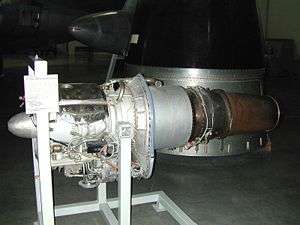Pratt & Whitney JT12
The Pratt & Whitney JT12, (US military designation J60) is a small turbojet engine. The Pratt & Whitney T73 (Pratt & Whitney JFTD12) is a related turboshaft engine.[2]
| JT12 | |
|---|---|
 | |
| A Pratt & Whitney JT12A turbojet | |
| Type | Turbojet |
| Manufacturer | Pratt & Whitney |
| First run | 1957 |
| Major applications | North American Sabreliner |
| Number built | 800+[1] |
| Variants | Pratt & Whitney T73 |
Design and development
The J60 conception and project design began in July 1957 at United Aircraft of Canada (now Pratt & Whitney Canada) in Montreal. The project design details were transferred to the main P&W company in East Hartford and in May 1958, the first prototype, with military designation YJ60-P-1 commenced testing.
Flight tests were completed in early 1959; followed by the delivery of the new JT12A-5 engines in July 1959. These were for the two Canadair CL-41 prototype trainers with a rating of 12.9 kN (2,900 lb st). The modified JT12A-3 turbojets with a basic rating of 14.69 kN (3,300 lb st) were tested in the two Lockheed XV-4A Hummingbird VTOL research aircraft. The next version, JT12A-21, had an afterburner which delivered a maximum thrust of 17.91 kN (4,025 lb st).
Variants
- Data from Janes[3]
- YJ60-P-1
- prototype
- J60-P-3
- J60-P-3A
- J60-P-4
- J60-P-5
- J60-P-6
- J60-P-9
- T73
- Military designation of the Pratt & Whitney JFTD12 free power turbine turboshaft version of the J60.
- JT12A-3LH
- JT12A-5
- (J60-P-3 / -3A / -5 / -6 / -9) Take-off ratings from 2,900 lbf (12.9 kN) to 3,001 lbf (13.35 kN).
- JT12A-6
- Essentially similar to the -5
- JT12A-6A
- JT12A-7
- (J60-P-4) up-rated to 3,300 lbf (15 kN)
- JT12A-8
- JT12A-8A
- JT12A-21
- An after-burning version developing 4,023 lbf (18 kN) thrust wet.
- FT12
- Turboshaft versions for marine use.
- JFTD12
- Company designation of the Pratt & Whitney T73 free power turbine turbo-shaft version of the J60.
Applications
Civilian (JT12)
- Lockheed JetStar
- North American Sabreliner
- Aérotrain Experimental 02 (French Touch in 60')
Military (J60)
- Lockheed XH-51
- Lockheed XV-4 Hummingbird
- Martin/General Dynamics RB-57F Canberra
- North American T-2B Buckeye
- North American T-39 Sabreliner
- Sikorsky S-69
Specifications (JT12A-8A)
Data from Aircraft engines of the World 1966/67[4]
General characteristics
- Type: Commercial turbojet
- Length: 78 in (2,000 mm)
- Diameter: 22 in (560 mm)
- Dry weight: 468 lb (212 kg)
Components
- Compressor: 9-stage axial compressor
- Combustors: Cannular - 8 burner cans in an annular casing
- Turbine: 2-stage axial turbine
- Fuel type: ASTM-A-1 / MIL-J-5624 / JP-1 / JP-4 / JP-5
- Oil system: Return pressure spray system at 45 psi (310 kPa)
Performance
- Maximum thrust: 3,300 lbf (14.68 kN)
- Overall pressure ratio: 6.7:1
- Air mass flow: 50.5 lb/s (1,370 kg/min)
- Turbine inlet temperature: 872 °C (1,602 °F; 1,145 K)
- Specific fuel consumption: 0.89 lb/lbf (91 kg/kN) per hour
- Thrust-to-weight ratio: 7.05
See also
Related development
Comparable engines
Related lists
References
- Connors, p.285
- Greg Goebel's Vectorsite
- Janes: JT12
- Wilkinson, Paul H. (1966). Aircraft engines of the World 1966/67 (21st ed.). London: Sir Isaac Pitman & Sons Ltd. p. 103.
- Connors, Jack; Allen, Ned (2010). The Engines of Pratt & Whitney: A Technical History. Reston. Virginia: American Institute of Aeronautics and Astronautics. ISBN 978-1-60086-711-8.
External links
| Wikimedia Commons has media related to Pratt & Whitney J60. |